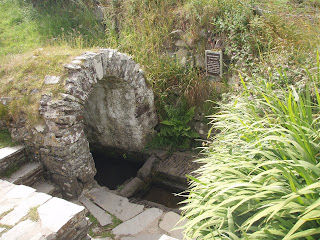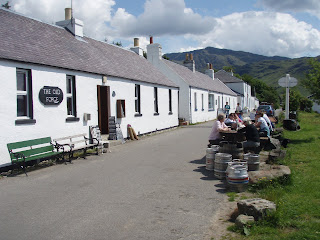
June 26 Once in royal St. David’s city
Of all the places I have visited in my travels so far, nowhere has been more charming, interesting and characteristically Celtic than St. David’s and the countryside and coastline which surrounds it. The centre-piece of Britain’s smallest city (it’s no bigger really than a medium-sized village) is, of course, its small but perfectly formed cathedral, which was unusually, but entirely sensibly, built, not on top of what
Of all the places I have visited in my travels so far, nowhere has been more charming, interesting and characteristically Celtic than St. David’s and the countryside and coastline which surrounds it. The centre-piece of Britain’s smallest city (it’s no bigger really than a medium-sized village) is, of course, its small but perfectly formed cathedral, which was unusually, but entirely sensibly, built, not on top of what
A Celtic jewel - St. David's cathedral
would inevitably have been a gale-swept hill, but at the bottom of a little valley. This means that, approaching the city from the surrounding countryside, all you can see of the cathedral is the pinnacles on top of its central tower. Only when you reach the valley itself is the full glory of the beautifully proportioned cathedral church revealed. Next to it are the romantic ruins of the Bishop’s Castle, and the Prince of Wales visited earlier this week, to open the newly restored cloisters. He must have been in his element!
There is something delightfully Celtic about the cathedral. It’s not just that it’s almost hidden away out of sight in its secret valley, but it was also built on a significant slope (upwards from west to east), the pillars in the nave seem to be leaning outwards and massive stone buttressing has had to be put in place to stop the north side collapsing. No Anglo-Saxon could ever have built a church like this!
Despite (or perhaps because of) its remoteness, St. David’s seems to have been something of a hub for Celtic Christianity. St. David was born here, of course. His mother, St. Non, gave birth to him on a hillside to the south of the city, in the middle of a violent thunderstorm. A holy well and a ruined chapel mark the spot.
ruined chapel mark the spot.
There is something delightfully Celtic about the cathedral. It’s not just that it’s almost hidden away out of sight in its secret valley, but it was also built on a significant slope (upwards from west to east), the pillars in the nave seem to be leaning outwards and massive stone buttressing has had to be put in place to stop the north side collapsing. No Anglo-Saxon could ever have built a church like this!
Despite (or perhaps because of) its remoteness, St. David’s seems to have been something of a hub for Celtic Christianity. St. David was born here, of course. His mother, St. Non, gave birth to him on a hillside to the south of the city, in the middle of a violent thunderstorm. A holy well and a
 ruined chapel mark the spot.
ruined chapel mark the spot. She then went on to Cornwall to found the church of Altarnun on the edge of Bodmin Moor, which is otherwise distinguished by being the home of the Western Morning News’ estimable farming editor, Peter ‘Bingo’ Hall, before heading off for more missionary work in Brittany.
On the other side of the city, close to the handsome beach of Whitesands Bay, a stone plaque indicates the site of what was once a
On the other side of the city, close to the handsome beach of Whitesands Bay, a stone plaque indicates the site of what was once a
St. Non's well - created when a bolt of lightning struck the ground whilst she was giving birth to St. David. Must have been an electrifying experience!
chapel dedicated to St. Patrick, to mark the spot where the Welshman who was to become the patron saint of Ireland, set off from his native land. If you are looking for evidence of the links that joined the Celtic cultures in the centuries before the Conquest, there is no shortage of it in and around St. David’s.
I’ve got to know St. David’s reasonably well over the last few years, in my role as a director of Farms for City Children. Treginnis Isaf, on the very tip of the peninsula, looking across to Ramsey Island, is the second of the three farms that Clare and Michael Morpurgo set up to take residential visits from inner city primary school-children. I visited on Thursday morning and was delighted to learn from Mike Plant, the farm school manager, that the enterprise is going from strength to strength. A party of 40 or so ten year olds from Dartford in Kent were in residence and had just finished the morning mucking out of goats and pigs. A happier, more polite, genuinely interested and talkative bunch of school kids you never met in all your life.
All this, and a golf course too. The City of St. David’s GC celebrated its centenary five years ago and I doubt if it has changed much in all that time. It was ferociously windy, but the views of over Whitesands to St.David’s head on one side of the bay and Ramsey island on the other, were stunning.
I’ve got to know St. David’s reasonably well over the last few years, in my role as a director of Farms for City Children. Treginnis Isaf, on the very tip of the peninsula, looking across to Ramsey Island, is the second of the three farms that Clare and Michael Morpurgo set up to take residential visits from inner city primary school-children. I visited on Thursday morning and was delighted to learn from Mike Plant, the farm school manager, that the enterprise is going from strength to strength. A party of 40 or so ten year olds from Dartford in Kent were in residence and had just finished the morning mucking out of goats and pigs. A happier, more polite, genuinely interested and talkative bunch of school kids you never met in all your life.
All this, and a golf course too. The City of St. David’s GC celebrated its centenary five years ago and I doubt if it has changed much in all that time. It was ferociously windy, but the views of over Whitesands to St.David’s head on one side of the bay and Ramsey island on the other, were stunning.

Still no surfing. The sea was far too wild, even for the professionals, let alone for ageing wallowers like me. I was planning to head off to the Gower to try my luck there, but the forecast spoke of unrelenting rain, so I decided to cut my losses and take a few days off at home. Next stop is Cornwall, somewhere near Tintagel, on July 6. Catch you then, and in the meantime, I'll add some pics.
Carn Llidi and Whitesands Bay from St. David's Head
























